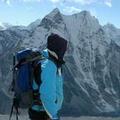 全球攀登聖母峰最多次的雪爾帕人將展開他第19次登上世界最高峰的行動,同時要把氣候保育訊息傳遞給全世界。
全球攀登聖母峰最多次的雪爾帕人將展開他第19次登上世界最高峰的行動,同時要把氣候保育訊息傳遞給全世界。
已經啟程的2009年聖母峰環保遠征隊隊長雪巴,會將印有「中止氣候變遷-讓喜馬拉雅山存留下去!」的世界自然基金會旗幟標語,以及裝有佛教貢品的金屬瓶帶到聖母峰頂。
希望在5月中攻頂的雪巴表示:「這是我第19次登上世界最高峰,而在過去18次的攀登經驗我已經見證了明顯不同的氣候環境。
「在聖母峰可以明顯感受到氣候變遷所引發的災難性後果,這是在氣候變遷到達臨界點之前,給予人類的一個警告。」
尼泊爾已經在面對氣候變遷的發生,從喜馬拉雅山北部山頂的嚴寒天氣,到南部低地平原酷熱的強烈氣候對比,可以明顯觀察到氣候變遷所產生的影響。
許多河流發源地的喜馬拉雅山冰河,由於持續升高的氣溫而逐漸縮小,讓依賴這些冰河做為水源的人民生計面臨威脅。
在尼泊爾進行的科學研究觀察,記錄了全球溫度和降水量最快持續增加的數據。
聯合國也表示,許多匯集冰河融化雪水的喜馬拉雅山湖泊面積擴大的相當快,甚至可能在10年決堤。
 2009年聖母峰環保遠征隊4月7日從加德滿都出發,此項由亞洲旅行公司所主辦的登山活動,將會適當地控制和處理遠征隊所造成的廢棄物和垃圾,同時也會儘可能將其他遠征隊所丟棄的垃圾帶下山。
2009年聖母峰環保遠征隊4月7日從加德滿都出發,此項由亞洲旅行公司所主辦的登山活動,將會適當地控制和處理遠征隊所造成的廢棄物和垃圾,同時也會儘可能將其他遠征隊所丟棄的垃圾帶下山。
在出發前往喜馬拉雅山之前,遠征隊代表團長史帝芬.雪巴和他的iDEAS團隊,4月3日起與桑波仁波切共同在加德滿都神形會展中心舉辦了一項為期10天、名為「將垃圾從高山清出」的展覽。
透過鼓勵企業和參觀民眾延長傳統旅行季節,這項活動預計將推廣和吸引大量的環保意識遊客前往尼泊爾。
尼泊爾國家旅遊局首席執行官Prachanda Man Shrestha表示:「對於山區部落來說,採取行動來解決氣候問題是必要的,而不是一昧期待其他國家代替我們來落實這些行動。」在稱讚當地居民主動處理全球暖化問題成果的同時,Shrestha也強調這些成果需要國際社會的支持。
The sherpa who holds the world's record for the most ascents to the summit of Mt. Everest has set off to climb the world's highest peak for a record 19th time, carrying a climate conservation message to the world.
As climbing leader of Eco Everest Expedition 2009 now making its way up the mountain, Apa Sherpa is carrying a WWF banner with the inscription "Stop Climate Change - Let the Himalayas Live!" and a metal vase containing Buddhist offerings up to the summit.
"This is my 19th climb to the top of the world. During the last 18 ascents, I have seen a measurable difference in the climatic conditions there," said Apa Sherpa, who hopes to reach the top in mid-May.
"The disastrous impacts of climate change are visible in the Everest region," he said. "It is a warning to the mankind before it reaches a tipping point."
Nepal is already subject to climate change and its effects are visible from the tops of the freezing Himalayas in the north, to the hot lowland plains of the south.
Himalayan glaciers, where many rivers originate, are shrinking due to rising temperatures threatening the lives of millions of people who depend on them for water.
Observations backed by scientific research in Nepal are recording some of the fastest long-term increases in temperatures and rainfall anywhere in the world.
Many Himalayan lakes, which collect glacier meltwater, are said by the United Nations to be growing so rapidly they could burst their banks within a decade.
The Eco Everest Expedition 2009 departed Kathmandu on April 7. Organized by Asian Trekking (P) Ltd., the expedition will properly manage and dispose of the human waste and other garbage generated by the expedition and will also try to bring down as much garbage as possible left on the mountain by other previous expeditions.
Before leaving for the mountain, Eco Everest Expedition 2009 overall leader Dawa Steven Sherpa and his iDEAS team together with Zangpo Rinpoche opened a 10-day art exhibition titled "Garbage Out of Thin Air" at the Imago Dei Cafe Gallery in Kathmandu on April 3.
This event is expected to promote and attract a greater number of eco-responsible tourists to the area by encouraging entrepreneurs and visitors to lengthen the traditional trekking season.
Prachanda Man Shrestha, chief executive of the Nepal Tourism Board, said, "It is necessary for mountain communities to take initiatives to solve problems rather than always expecting our foreign friends to do it on our behalf." While praising efforts to tackle global warming problems at the local level, he emphasized the need for the international community to support these efforts.


